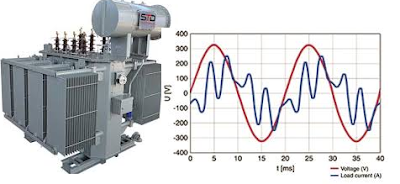The transformer does not generate harmonics. The transformer has primary and secondary windings, which are inductive. The inductive load draws current linearly with the applied voltage. However, the transformer generates harmonics in two conditions.
When transformer is energized the magnetizing current drawn by it is non linear and it generates harmonics. This is because, when transformer is energized the back emf is zero and transformer draws huge magnetizing current which is not sinusoidal. The magnetizing current is rich in the 2nd-order harmonic current.

The second condition is the over-excitation of the transformer. Over-excitation means the transformer is operated at a flux density that is higher than its rated flux density. Under the over-excitation of the transformer, the 5th-order harmonic current is produced. The above two conditions happen for a short period of time, and thus, the 2nd and 5th-order harmonics are not a serious problem.
The transformer’s primary function is to feed power to the load. The nature of the load decides whether the load current waveform has harmonics or not. If the load is linear, no harmonics are produced, and if the load is nonlinear, the harmonics are produced in the electrical network.
Nowadays, power electronics are widely used for better control of the drives, and they are used for energy saving. If the converter and /or inverter used are of 6 pulse configuration, the lower order harmonics 5th and 7th are predominant, and it harms the power system because the magnitude of the lower order harmonics is more in comparison with the magnitude of the higher order harmonics. Whatever harmonic order current is produced by the load flows in the primary and secondary of the transformer.
The transformer is supposed to feed the sinusoidal current at its rated kVA. However, if the current flows through the transformer winding, it adversely affects the transformer’s performance. If the magnitude of the harmonic current is higher, it also distorts the input voltage of the transformer. The harmonics cause the following adverse effects on the transformer’s performance.
Effect of Harmonics on Iron Loss
The core or iron loss of the transformer is the loss that occurs due to eddy current loss and hysteresis loss. The hysteresis loss is directly proportional to the frequency, and eddy current loss is directly proportional to the square of the frequency. Thus, it is clear that the iron loss gets increased with increase in frequency. The harmonic current is the integral multiple of the fundamental frequency, and harmonic current may have frequencies of 100 Hz, 150 Hz, 200 Hz, 250 Hz, and so on. Thus, the iron loss of the transformer increases if a harmonic-rich current flows through the transformer.
Effect of Harmonics on Copper Loss
The tendency of current flow at the outer surface of the conductor is known as the skin effect. The higher frequency current tends to flow at the outer surface of the conductor. When the current flows at the outer surface of the conductor, the effective cross-section area of the conductor gets reduced. The reduction in the effective cross-section area leads to an increase in the conductor resistance. The higher resistance of the conductor causes more copper loss(I2R) in the transformer. Thus, the copper loss of the transformer increased with an increase in the harmonic current.
Effect of Harmonics on Efficiency of Transformer
The efficiency of the transformer is defined as the ratio of output power to input power.
Efficiency = Output Power/ Input Power
= Input power- Losses/ Input Power
= 1 – Losses/Input Power
With the increase in losses in the transformer due to harmonics, the efficiency of the transformer decreases.
Harmonics Cause De-rating of Transformer
If the transformer is operated at X kVA when harmonic current is absent, it needs to be operated at lower kVA if the transformer is operated with harmonic current to control the temperature rise of the transformer.
In a nutshell, we can say that the transformer needs to be de-rated if it is to be operated in harmonic rich current.
If the load characteristics are known to be nonlinear and the total harmonic distortion(THD) of the load is known, the transformer of inverter duty must be selected for reliable transformer operation.
The harmonic current causes voltage distortion at the input side of the transformer. The harmonic distortion in voltage causes the following adverse effects on the performance of the transformer.
1. Increased dielectric stress on insulation
2. Resonance between the winding reactance and feeder capacitance
3. EMI and RFI interference with the communication circuit
1 thought on “Effects of Harmonics on Transformers”